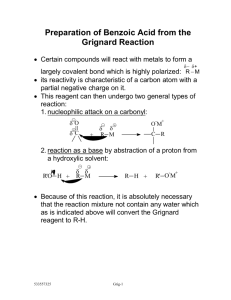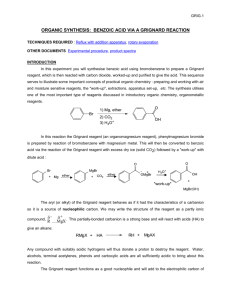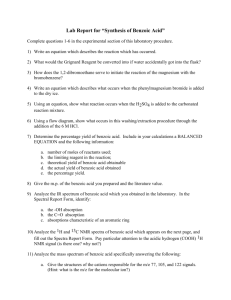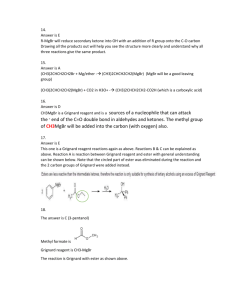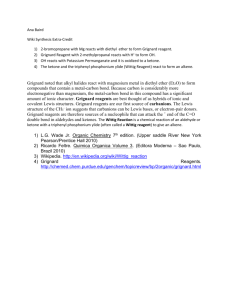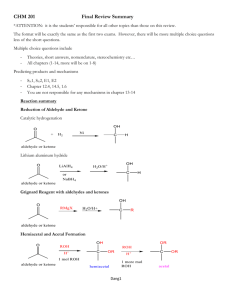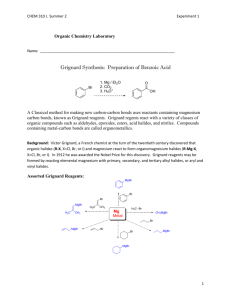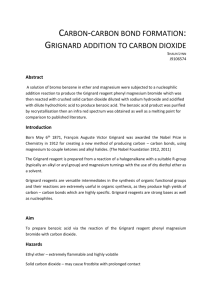Grignard Reagent / Reactions
advertisement
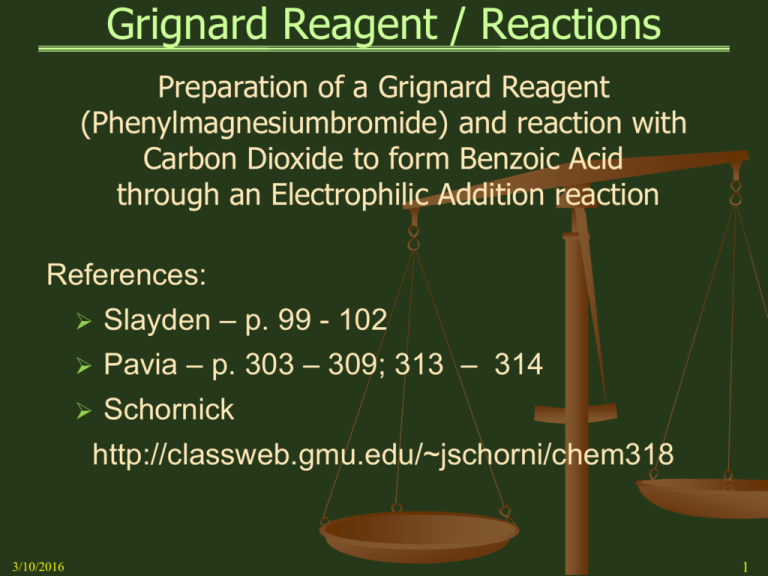
Grignard Reagent / Reactions Preparation of a Grignard Reagent (Phenylmagnesiumbromide) and reaction with Carbon Dioxide to form Benzoic Acid through an Electrophilic Addition reaction References: Slayden – p. 99 - 102 Pavia – p. 303 – 309; 313 – 314 Schornick http://classweb.gmu.edu/~jschorni/chem318 3/10/2016 1 Grignard Reagent / Reactions Synthesis of Benzoic Acid – Electrophilic Addition reaction between a freshly prepared Grignard Reagent (Organomagnesium Halide) acting as the Nucleophilie (Lewis Base) and the Carbonyl group of Carbon Dioxide acting as the positively charged Electrophile The Grignard Reagent must be prepared and reacted with the solid Carbon Dioxide before the end of the day Sonication of mixture of Magnesium, Bromobenzene & Ether (Ether acts as solvent and Grignard stabilizer) Reaction between Grignard Reagent and Carbon Dioxide Hydrolysis of Acid Salt Product Separation – Liquid/Liquid Extraction Precipitation Vacuum Filtration Product Purification– Recrystallization Product Verification– Melting Point 3/10/2016 2 Grignard Reagent / Reactions Laboratory Report: Synthesis Experiment Mass, Moles, Molar Ratio, Limiting Reagent, Theoretical Yield Procedures Title – Concise: Simple Distillation, Dry Sample, IR Spectrum, etc. Materials & Equipment (2 Columns in list (bullet) form) Note: include all reagents & principal equipment used 3/10/2016 Description: Descriptions must be detailed, but concise Use list (bullet) form Use your own words (don’t copy book) 3 Grignard Reagent / Reactions Laboratory Report: (Con’t) Results – Neat, logically designed template to present results Summary 3/10/2016 Paragraph summarizing experimental observations, computed results, and principal absorptions from IR & NMR Analysis & Conclusions Limiting reagent Discuss the reaction in context with the results you obtained; what evidence do you have to indicate you got the intended product? Yield – How could the experimental process be improved? 4 Grignard Reagent / Reactions Background: Grignard Reagents, aka, Organomagnesium Halides Prepared by Reaction of an Organic Halide and Magnesium metal turnings, usually in an Ether solvent Relative Reactivity of Halides is important RI > RBr > RCl > RF 3/10/2016 Very few Organomagnesium Fluorides are produced. Aryl Grignards are more easily prepared from Aryl Bromides and Aryl Iodides than Aryl Chlorides Grignard Reagents are seldom isolated, but they can be stabilized briefly in Ether solution and then used in the preparation of other compounds The preparation of a Grignard Reagent usually produces a high yield (85 – 95%) 5 Grignard Reagent / Reactions Reactions: – – – – – 3/10/2016 – + + – + – + + – – 6 Grignard Reagent / Reactions 3/10/2016 Reactions (Con’t): The Alkyl portion of the Grignard reagent behaves as if it had the characteristics of a Carbanion – the carbon atom bears a formal negative charge The Magnesium portion bears the positive charge Grignard Reagent, thus, acts as a Strong Base and is a strong Nucleophile that acts as a Lewis Base donating an Electron pair to a positively charged Electrophile Especially useful in Nucleophilic Addition reactions of the Carbonyl group, which has electrophilic character where the positive charge of the carbonyl carbon atom is attractive to the Grignard Nucleophile 7 Grignard Reagent / Reactions Reactions (Con’t): Grignard & CO2 to produce Benzoic Acid Grignard & Ketone to Produce Tertiary Alcohol 3/10/2016 8 Grignard Reagent / Reactions Reactions (Con’t) Grignard & Aldehyde to Produce Secondary Alcohol Grignard & Formaldehyde to Produce Primary Alcohol 3/10/2016 9 Grignard Reagent / Reactions Grignard with Benzophenone to form Triphenylmethanol 3/10/2016 10 Grignard Reagent / Reactions Grignard with Dry Ice (Solid CO2 ) to form Benzoic Acid Salt, which is then hydrolyzed with HCL to form Benzoic Acid Today’s Experiment 3/10/2016 11 Grignard Reagent / Reactions Preparation of Benzoic Acid: Experimental Precautions The Grignard reaction is very reactive. It must be used in a reaction as soon as it is created. Moisture must be avoided. Water acts as an Acid in this reaction; thus the acid proton competes for the Magnesium in an acid – base reaction. Therefore, moisture could result in the formation of a Hydrocarbon – R-H R:MgX + H:OH R-H Stronger Base 3/10/2016 Stronger Acid + Weaker Acid HO- + Mg+2 + X- Weaker Base Anhydrous Ether is used to stabilize the Grignard 12 Grignard Reagent / Reactions Use as little heat as possible to avoid formation of Biphenyl Note: The Biphenyl produced from excessive heat is not the same as the Hydrocarbon formed in an acid - base reaction above. 3/10/2016 The Organic Ether layer contains Benzoic Acid, Biphenyl and Inorganic Salts. The Benzoic Acid is separated from the Biphenyl by converting it to an aqueous soluble form by washing with NaOH 13 Grignard Benzoic Acid Procedure Procedure (Ultrasonic Bath Version) NOTE: Water/Moisture must be avoided: “All glassware must be “dry” 3/10/2016 Weigh a little more than 0.5g of Magnesium (Mg) (MW – 24.31) to the nearest 0.001 g and place the Magnesium in a large oven-dried Test Tube or Centrifuge Tube Obtain a vial of Bromobenzene (MW – 157.01) and weigh it to the nearest 0.001g Transfer the Bromobenzene to the test tube containing the Magnesium filings Reweigh the empty vile to obtain the net mass of Bromobenzene 14 Grignard Benzoic Acid Procedure 3/10/2016 Procedure (Ultrasonic Bath Version) (Con’t) Add about 10 mL of Anhydrous Ether to the test tube containing the Bromobenzene and Magnesium Add a very small piece of “Iodine” to the mixture Add a cotton ball to the top of the test or loosely screw a cap on the Centrifuge tube (if used) Place the tube in the Sonication Bath to stimulate the reaction. The solution will begin to turn brownish/gray as the reaction proceeds After about 5 minutes in the Sonication bath, remove the tube and gently swirl the mixture to insure maximum exposure of the Magnesium filings to the Bromobenzene 15 Grignard Benzoic Acid Procedure 3/10/2016 Procedure (Ultrasonic Bath Version) (Con’t) Replace the tube in the Sonication bath for about 40 minutes or so Remaining in the Hood, remove the tube containing the Grignard reaction mixture from the Sonication Bath Pour the solution over approximately 10 g of Dry Ice (solid CO2) in a labeled 150 mL beaker. Leave the unreacted Magnesium particles in the Centrifuge tube Rinse the tube with a few mL of Ether and add the Ether to the beaker containing the product Store labeled beaker containing your product in the hood until next lab session 16 Grignard Benzoic Acid Procedure Week 2 - Hydrolysis & Purification of Benzoic Acid Slowly add about 10 mL of 6 M HCl to the beaker containing the product Stir and scrape contents of the beaker with the spatula until the solids and liquid form a uniform mixture The mixture may show some reaction activity, such as frothing and increased temperature, which might include the reaction between any remaining Magnesium and the HCl to evolve Hydrogen add 10 mL Methyl –t-Butyl Ether to the beaker Continue to stir and scrape the mixture with a spatula If solids still persist in the solution, use a medicine dropper and add small additional amounts of Methylt-Butyl Ether and stir 3/10/2016 17 Grignard Benzoic Acid Procedure Week 2 - Hydrolysis & Purification of Benzoic Acid If some solids are still insoluble in either the ether layer or the aqueous layer, add small amounts of the 6 M HCl and stir. Keep track of the volume of HCL added There should be two distinct clear layers in the beaker Note: The Benzoic Acid (and any by-product Biphenyl) is soluble in the Ether The inorganic compounds (MgX2) are soluble in the aqueous phase 3/10/2016 18 Grignard Benzoic Acid Procedure Week Two - Hydrolysis & Purification of Benzoic Acid 3/10/2016 Liquid/Liquid Extraction: Transfer the mixture to a 125 mL Separatory funnel Rinse sides of beaker with additional ether and add to Separatory funnel Insert stopper and secure it with your finger Shake the mixture gently, invert funnel, point stem up and away from your face and slowly open stopcock to vent any gas Allow the layers to separate (remove stopper) Discard the aqueous (lower) phase into a separate waste beaker and put aside 19 Grignard Benzoic Acid Procedure Week Two - Hydrolysis & Purification of Benzoic Acid Liquid / Liquid Extraction with Distilled Water (Con’t) ● Add 5 mL distilled water to the organic solution ● Shake the mixture gently, invert the funnel, and slowly open stopcock to vent any gas ● Allow the layers to separate (remove stopper) ● Discard aqueous phase ● Repeat the liquid/liquid extraction with an additional 5 mL of distilled water 3/10/2016 20 Grignard Benzoic Acid Procedure Week Two - Hydrolysis & Purification of Benzoic Acid 3/10/2016 Liquid / Liquid Extraction with Sodium Hydroxide To the organic layer, which contains the Benzoic Acid and by-product Biphenyl, add 5 mL 5% NaOH Shake the mixture gently, invert funnel pointing away from your face, and slowly open stopcock to vent any gas Allow the layers to separate (remove stopper) Drain aqueous (bottom) layer into clean, dry 100 ml beaker Repeat liquid/liquid extraction with another 5 ml 5% Sodium Hydroxide, draining bottom layer into your beaker Repeat liquid/liquid extraction a 3rd time with 5% Sodium Hydroxide 21 Grignard Benzoic Acid Procedure Week Two - Hydrolysis & Purification of Benzoic Acid Liquid / Liquid Extraction with Sodium Hydroxide (con’t) Note: The Sodium Hydroxide converts the Benzoic Acid to the water-soluble Sodium Benzoate salt The Sodium Benzoate is thus transferred to the aqueous phase 3/10/2016 Discard the organic Ether layer into the waste jar in the hood 22 Grignard Benzoic Acid Procedure Week Two - Hydrolysis & Purification of Benzoic Acid Remove Excess Ether Gently heat the combined aqueous extracts (about 15 mL) containing the Benzoic Acid salt on a hot plate (set setting at 3-4) until formation of small bubbles (Ether) ceases. This removes any residual Ether, which is slightly soluble in water Note: Don’t overheat; heat just enough to boil off Ether 3/10/2016 23 Grignard Benzoic Acid Procedure Week Two - Hydrolysis & Purification of Benzoic Acid Cool the solution to room temperature Add 10.0 mL 6 M HCl and stir (a precipitate forms in the beaker) Note: If little or no precipitate forms add an additional 3 ml HCL. If no precipitate forms inform instructor 3/10/2016 Cool mixture in water/ice bath Vacuum Filtration Vacuum filter the product using a Buchner Funnel Wash crystals on the filter 2 times with 5 mL cold distilled water 24 Grignard Benzoic Acid Procedure Week Two - Hydrolysis & Purification of Benzoic Acid Recrystallize product from hot (near boiling) water Transfer solid from Buckner Funnel to 100-150 mL beaker using cold Distilled Water to insure complete transfer Add an additional 15 mL of distilled water to mixture Heat solution to just below boiling point, swirling the mixture occasionally until all solids go into solution Note: The Benzoic Acid solution gives off a strong pungent vapor; avoid proximity to nose 3/10/2016 Check with instructor if you feel additional Distilled Water is needed to effect total solution 25 Grignard Benzoic Acid Procedure Week Two - Hydrolysis & Purification of Benzoic Acid 3/10/2016 Recrystallize Product (Con’t) Allow solution to cool slowly to room temperature effecting recrystallization of the purified product (Soluble impurities remain in solution If the cooled solution does not appear to have sufficient water to suspend the purified crystals as a slurry, add 10 ml of Distilled Water, redissolve the mixture, and cool again slowly to room temperature After mixture has reached room temperature, place the beaker in an ice/water bath for about a minute 26 Grignard Benzoic Acid Procedure Week Two - Hydrolysis & Purification of Benzoic Acid 2nd Vacuum Filtration Clean and dry the Buckner Funnel, add a new filter, and weigh it to the nearest 0.001g ● Assemble the Buckner Funnel and vacuum filter the product ● Wash crystals on the filter with 5 mL cold Distilled Water ● Dry the product in a pre-weighed weighing tray in the class drawer until next week 3/10/2016 27 Grignard Benzoic Acid Procedure Week Two - Hydrolysis & Purification of Benzoic Acid Weigh the dried product & weighing tray to the nearest 0.001g Compute the mass of product (Benzoic Acid) by difference Determine the % yield Determine the melting point of the product (MP of Benzoic Acid – 122.4oC) NOTE: If little or no yield was obtained, see next slide 3/10/2016 28 Grignard Benzoic Acid Procedure The Experiment was a Bust!! Occasionally students get little or no yield for the Grignard / Benzoic Acid experiment The principal reason for this is the failure of the original reaction between Bromobenzene and Magnesium to form the Grignard Reagent There are two main indications of a failed reaction: 3/10/2016 No precipitate forms upon the addition of the 6 M HCL to the aqueous NaOH washings The precipitate largely disappears after the first vacuum filtration 29 Grignard Benzoic Acid Procedure The Experiment Was a Bust 3/10/2016 In order to give the students full exposure to the complete procedure, the following steps should be performed: Weigh out to the nearest 0.001 g approximately 3 grams of Benzoic Acid supplied by the instructor Dissolve the Benzoic Acid in 15 mL Anhydrous Ethyl Ether. Wash the Ether phase 3 times with 5 mL 5% NaOH as before combining the 3 aqueous washings in a beaker Discard the Ether 30 Grignard Benzoic Acid Procedure The Experiment Was a Bust 3/10/2016 Gently heat the NaOH solution, approximately 15 mL, to drive off any residual Ether Cool the solution to room temperature Add 10 mL HCL, as before, and place in water-ice bath A precipitate should form Separate the precipitate by vacuum filtration Wash product on filter with 5 mL cold water Recrystallize the product from hot distilled water Vacuum Filtration Dry the Product Determine the Melting Point 31 Grignard Benzoic Acid Procedure Note: Lab procedure sequence vs. Lab report procedure sequence 3/10/2016 The writing of the laboratory report does not always follow the exact physical sequence of procedures used in the lab The measurement of the Mass of a reagent may be immediately followed by an apparatus set-up or transfer of the sample to a piece of apparatus This same process could be repeated with the second or a third reagent used in the experiment In your report, however, all determinations of Mass are followed immediately by all calculations that can be based on the Mass values, i.e. moles, molar ratios, limiting reagent, theoretical yield, etc. 32 Grignard Benzoic Acid Procedure 3/10/2016 In the Grignard experiment the following calculations are carried out before any procedure dealing with the mixing of the reagents and subsequent processing of the reaction mixture Mass of first reagent Mass of second reagent (HCL – Vol & Density) Moles of both reagents (1 procedure) Set up Balanced Stoichiometric Equation Determine Molar Ratio Determine Limiting Reagent Compute Theoretical Yield 33 Grignard Benzoic Acid Procedure Use the following table form (handout) as a substitute for the table in the Lab Manual Data Report. Balanced Equation Mg Ether CO2 HCl Mixed Salts Mol Wgt Grams Moles 3/10/2016 34 Grignard Benzoic Acid Procedure Hydrolysis of Benzoic Acid Salt Ether Layer 8 mL 6 M HCL 20 mL Anhydrous Ether Separatory Funnel (Shake Gently) Benzoic Acid Biphenyl Aqueous Layer Inorganic Salts (Discard) Add 5 mL 5% NaOH Aqueous Layer (Repeat 3 Times) Biphenyl (Discard) Soluble Benzoic Acid Salt (Trace of Ether) Heat on Hot Plate in Hood to Drive off Ether Cool to Room Temperature Add 10 mL 6 M HCl 3/10/2016 35

